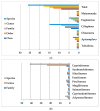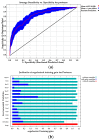Protozoan Parasites of Iranian Freshwater Fishes: Review, Composition, Classification, and Modeling Distribution
- PMID: 37242321
- PMCID: PMC10223472
- DOI: 10.3390/pathogens12050651
Protozoan Parasites of Iranian Freshwater Fishes: Review, Composition, Classification, and Modeling Distribution
Abstract
This article investigates the occurrence and distribution of parasitic protozoa of Iranian freshwater fishes (both farmed and wild). Our search shows 26 known parasitic protozoan species were recorded from 52 freshwater fish species across different ecoregions of Iran. Most of these fish are edible. While none of the identified protozoan parasites are of zoonotic importance, our study does not exclude presence of zoonotic species in Iranian fishes. Present data suggest the northern and western regions of the country are the main macrohabitat of protozoa (35 parasitic records reported), with the greatest concentration of parasitic protozoa occurring in the Urmia basin in Iran's northwest. The clustered distribution pattern of protozoa among freshwater fish was also more evident in the northern and western parts of the country. The gills and skin were the most infected microhabitats for parasitic protozoa. The highest number of parasites was observed in the fish family Cyprinidae with nine species found in the native fish, Capoeta capoeta. The most diverse host range was observed in the holotrich ciliate, Ichthyophthirius multifiliis isolated from 46 cyprinid species in 39 different locations. However, due to the great richness of fish and extreme habitat diversity, parts of the parasite fauna of Iranian freshwater fish are still poorly understood. Furthermore, current and future changes in climate and environmental parameters, and anthropogenic interventions are likely to affect fish hosts and their parasites.
Keywords: Iran; checklist; freshwater fish; geographical distribution; protozoan parasites.
Conflict of interest statement
There are no conflicts of interest.
Figures








References
-
- Zilberg D. Amoebic gill disease of marine fish caused by Neoparamoeba pemaquidensis. Acta Zool. Sin. 2005;51:554–556.
-
- Marino F. Damage due to parasites in Mediterranean teleosts. Parassitologia. 2006;48:19–21. - PubMed
LinkOut - more resources
Full Text Sources

